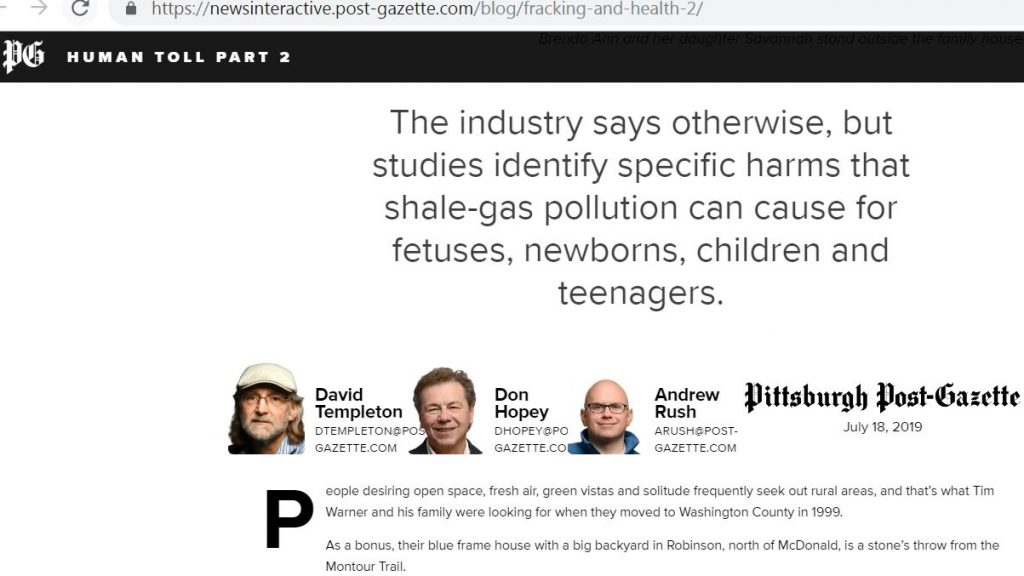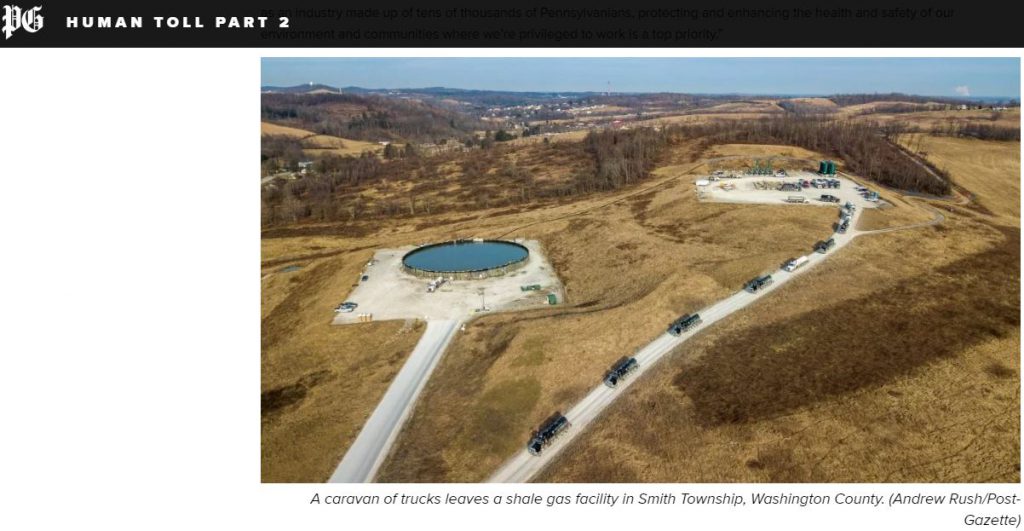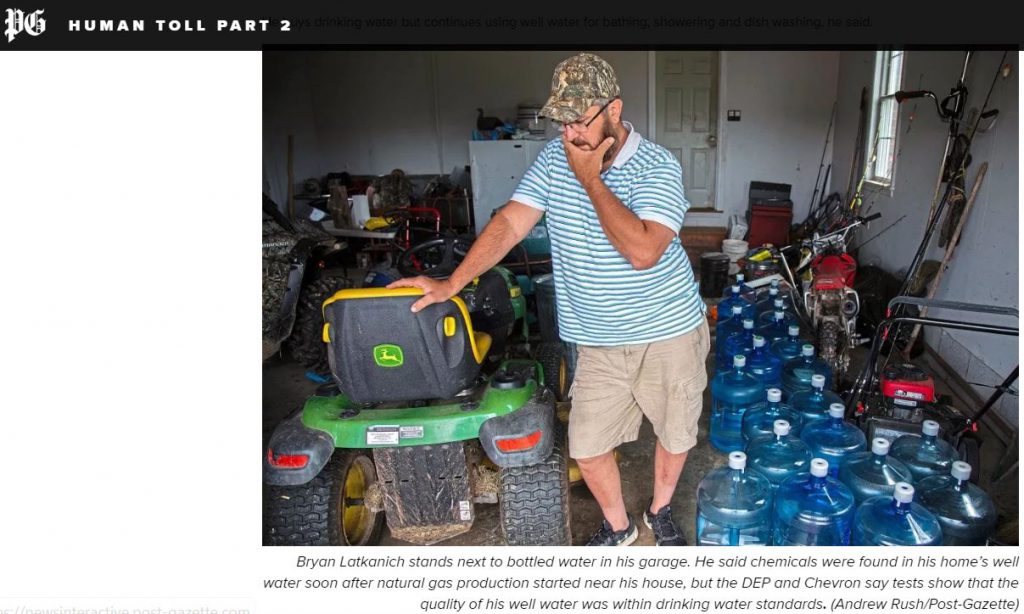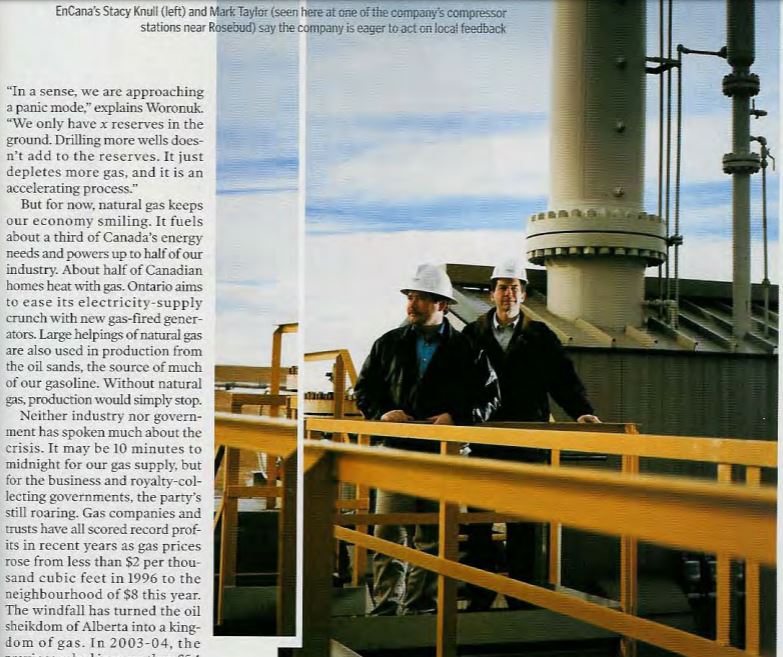The industry says otherwise, but studies identify specific harms that shale-gas pollution can cause for fetuses, newborns, children and teenagers by David Templeton, Don Hopey, Andrew Rush, July 18, 2019, Pittsburgh Post-Gazette
[Excellent interactive visuals at above link]

People desiring open space, fresh air, green vistas and solitude frequently seek out rural areas, and that’s what Tim Warner and his family were looking for when they moved to Washington County in 1999.
As a bonus, their blue frame house with a big backyard in Robinson, north of McDonald, is a stone’s throw from the Montour Trail.
But some of what they were fleeing when they left their apartment in Moon is even worse, particularly the heavy truck traffic and foul air.
Pollution science is clear even if the skies are not. For every ton of airborne pollution, there’s a well-defined impact on human health, and more specifically, mortality.
In 2010, the Post-Gazette published its own epidemiological study of pollution’s impacts that showed 14 counties in southwestern Pennsylvania had 14,636 excess deaths from 2000 through 2008, when compared with the national average. Many of those additional deaths showed up in municipalities downwind from pollution-spewing, coal-based power, coke and steel plants.
As part of the Post-Gazette’s effort to update the 2010 “Mapping Mortality” project, Nicholas Muller, an economist at Carnegie Mellon University, was asked to study current air pollution and related mortality, and that review predictably — given the closure of many coal-fired power plants — shows pollution-related deaths in decline.
However, the Muller study also shows that deaths from locally generated pollution were in decline from 2008 until 2011, but then increased by about 100 deaths from 2011 to 2014. He said this reflects increases in locally emitted pollution — most likely from increases in local economic activity and the shale gas industry.
Further reading: The Human Toll Part 1, Risk and exposure in the gaslands

Young cancer patients are shown from left: Nicole Stewart, 19, of McDonald is in remission; Braedyn Wasko, 12, of Crucible is in remission; Anya La Mar of North Fayette died at age 11 in 2016; Savannah Partridge, 12, of North Strabane is in remission.
Goose hunting and walks on the trail ended for them in about 2016 with the drilling and fracking of three nearby shale-gas wells and construction of two gas-compressor stations in the Cibus-Imperial complex less than a half mile southwest of their house.
Family members say they’ve become prisoners in their own home — a bunker sealing them off from truck noise and exhaust and other forms of pollution that triggers asthma attacks, nosebleeds, headaches and other health problems.
The Post-Gazette wrote extensively in the spring about high numbers of cancer cases, many of them rare types, diagnosed in children and young adults in the Canon-McMillan School District and in rural counties with shale-gas operations. While no study shows a direct link between cancers and shale-gas drilling, that is not the case with some of the other ailments affecting children in the region.
The link between the Warners’ health problems and pollution is reflected in a recent compendium of 1,778 peer-reviewed studies about shale-gas industry operations. It found that “90.3% of all original research studies published from 2016-2018 on the health impacts of fracking show a positive association with harm or potential harm.”
Released in June, the sixth edition of the Compendium of Scientific, Medical and Media Findings Demonstrating Risks and Harms of Fracking (Unconventional Gas and Oil Extraction) also found that a majority of the studies show potential for, or actual evidence of, water contamination and significant air-pollutant emissions. The compendium, compiled by Medical Professionals of New York and Physicians for Social Responsibility, is updated regularly with new studies.
But, in response to Post-Gazette inquiries about the health impacts of shale oil and gas operations, David J. Spigelmyer, president of The Marcellus Shale Coalition, an industry group, said in an eight-page statement that “protecting and improving our environment is our industry’s top priority.” Pennsylvania’s shale industry “has a demonstrated track record of safe, responsible and highly compliant operations,” he said.
Coalition spokesman John Sutter said Mr. Spigelmyer declined to be available for an in-person interview.
“Shale development is a safe, tightly regulated process that’s governed by nearly 70 federal, state and local regulations and monitored by 30 state and federal agencies,” the coalition said, claiming emissions below “health protective levels” with “no credible link to cancer.”
“We are disappointed that some activists choose to sensationalize tragedy and make inflammatory suggestions that run counter to the views of respected medical experts, top environmental and health regulators, and because of scientific data and research as an industry made up of tens of thousands of Pennsylvanians, protecting and enhancing the health and safety of our environment and communities where we’re privileged to work is a top priority.”

A caravan of trucks leaves a shale gas facility in Smith Township, Washington County. (Andrew Rush/Post-Gazette)
The Warners, however, say they are are convinced that their health troubles are linked to pollution, including that from truck traffic and shale-gas operations.
Tim, 58, had to give up goose hunting and often stays inside because he can’t breathe outdoors.
“He’s getting worse,” said his wife, Brenda Ann, 51, who said she is the only one in the family without asthma. “He can’t be on the porch, especially with trucks going by with that smell of fuel.”
Their major concern, though, is the health of their daughters.
Savannah, 21, developed asthma while attending Fort Cherry High School. So did her sister, Serena, 15, who still has trouble breathing what they describe as “the heavy air” whenever she steps outside their home or goes to school. The Fort Cherry campus also is surrounded by shale-gas-well drilling and fracking operations.

The Fort Cherry School senior high school in Mt. Pleasant, Washington County, is surrounded by shale-gas operations. The Chiarelli well pad is visible in this photo just above the silo. Several Fort Cherry parents say their children have had asthma attacks, headaches and nosebleeds, sometimes severe and often while at school. (Andrew Rush/Post-Gazette)
Serena began having headaches and nosebleeds in 2016, mostly at school, leading to her diagnosis of Von Willebrand disease — a disorder in which the blood-clotting protein known as the Von Willebrand factor is defective or absent. The disease can be genetic, but Ms. Warner said she has found no cases of it in their family history. There’s also an acquired form of the disease.
A 2009 German Research Center for Environmental Health study, among others, found that “the Von Willebrand factor antigen showed a consistent decrease,” indicating a reduction in clotting ability, “in association with almost all air pollutants.” Other studies have shown that pollution can impact the factor but not cause the disease.
Parents of several other Fort Cherry students told the Post-Gazette that their children also have had sudden and unexplained asthma attacks, headaches and nosebleeds at school. One student, in addition to asthma, has joint problems and lab results show levels of benzene in her blood that her guardian said are elevated. Benzene is a pollutant generated by shale gas operations.
Serena’s mother says medication for her blood disorder has helped, but added that the main reason for her improvement is that she stays indoors.
For the entire family, the rural lifestyle amid shale-gas operations have become “just stressful,” Ms. Warner said.
Multiple studies link pollution exposure to asthma or asthma exacerbation, with evidence that it also can lead to headaches, nosebleeds, neurological problems, fatigue, depression and other maladies.
A 2017 peer-reviewed study by Dr. Deborah Gentile of the Pediatric Alliance in the Allegheny Health Network found that “eight school systems exposed to the highest levels of particulate pollution from industrial sources had 1.6 times the risk of an asthma diagnosis.” It also determined there was a “nearly five times greater prevalence of uncontrolled asthma linked to outdoor air pollution” than other asthma triggers.
Environmental group Earthworks used a FLIR camera to capture infrared video of emissions from one of the two Cibus-Imperial compressor stations in Robinson, Washington County. The emissions are especially visible toward the end of the video. (Earthworks)
But the health impacts with the strongest conclusions in shale-gas research — including that in the compendium and in independent University of Pittsburgh research — involve mothers who live near shale-gas operations. They can face high-risk pregnancies, preterm births and low birth-weight babies.
A University of Colorado School of Public Health study found evidence that gas industry pollution creates elevated risks of fetal death and birth defects of the brain, spine and spinal cord, including spina bifida. Yet another study showed moderate evidence of an increased risk of miscarriages and birth defects.
(Our industry) has a demonstrated track record of safe, responsible and highly compliant operations.
Monitoring of air pollution concentrations near shale gas sites often fails to detect levels known to impact health, studies show. But medical research now is documenting health effects from shale-gas pollution exposure at levels below established safety thresholds.
Health outcomes generally worsen the closer a person lives to shale gas operations, according to a UCLA Health Sciences review of 37 studies on health hazards associated with oil and natural gas extraction.
The review also found that existing health benchmarks “fail to adequately address potential risks associated with long-term, chronic, lower levels of exposure, or from the mixture of chemicals.”
Pollution sampling methods also can fail to account for the degradation and dispersion of pollutants. Time frames when pollution levels are measured also “may not capture peak emission periods characteristic of oil and natural-gas extraction,” the review said.
These and other health and environmental concerns prompted New York, Maryland and other states, counties and municipalities to ban fracking operations within their borders.
WHEN YOU SMELL THAT SMELL
Phyllis Carr, 67, and her daughter, Jeaney Ann Carr, 44, live in neighboring houses in the Lake Lynn section of Springhill Township in Fayette County.
A gas compressor station operates on a hillside 1,600 feet from their homes. A shale-gas well, drilled and fracked in 2010, sits just 500 feet away, atop a ridge above their properties. The well pad is so close that their windows and walls vibrated during drilling and fracking, they said.
Once, when Jeaney Ann’s twin sons, Nathan and Daniel, were playing outdoors, she called them inside as the familiar industrial smell from gas operations filled their valley. Later, while retrieving their toys, Jeaney Ann said, she saw a white haze and iridescent bubbles in the air. She showed a reporter photos of those bubbles.
The smell left her dizzy, then ill, she said. Her skin burned and itched, she began shaking and her face turned red. Later she developed painful blisters in her nostrils and had trouble swallowing, causing her over time to lose nearly 100 pounds.
At the same time, Jeaney Ann’s son Daniel started having seizures while sleeping. Then his hands began to shake. In time, Nathan’s head began twitching and his hands trembled. Jeaney Ann and Phyllis said they instructed the boys to rush inside whenever they smelled that smell.
When he dismissed concerns about his health, Ms. Carr told him, ”Hold out your hand.”
Entering fourth grade, the boys also “started acting like crazy kids,” Phyllis said, noting their erratic behavior and declining grades.
“We lived here all of our lives and raised kids and never had a problem before this,” she said. “Then boom, [gas operations] occurred and everything started happening.”
The boys’ neurologist, Dr. Felix Brizuela of Harrison City, who had offices in Connellsville and Morgantown, W.Va., told her the boys had “taken a neurological hit” from pollution exposure, Ms. Carr said.
Ms. Carr said Dr. Brizuela alerted Albert Gallatin School District officials, in writing, that the boys’ medical problems likely were related to pollution exposure. He also prescribed them the antipsychotic drug risperidone to improve thinking, mood and behavior.
(Earlier this year, Dr. Brizuela was convicted by a federal jury on 15 counts of illegally distributing controlled substances outside the bounds of professional medical practice. He’s appealing that conviction.)
Their diagnoses mirror that of Delma J. Burns, 81, a neighbor of the Carrs, who said she, too, experienced “horrible, uncontrolled shaking and trembling with night sweats and light seizure activity, memory loss, confusion and neuropathy” after shale-gas operations got underway nearly a decade ago.
Dr. Brizuela provided Ms. Burns with a written diagnosis, shared with the Post-Gazette, that linked her medical problems to exposure to shale-gas pollution.
One day last fall, Daniel, now 18, was deer hunting in the same narrow valley where his mother and grandmother still live. All was well, he said, explaining that he had moved on with life after a childhood chock-full of health concerns.
But when he dismissed concerns about his health, Ms. Carr told him, “Hold out your hand.”
Reluctantly, he adjusted the rifle he was cradling in his arm and held out a hand that shook uncontrollably.
Alex Freiberger, 22, grew up on Walnut Road in Mt. Pleasant, Washington County, half a mile behind Range Resources’ Carter Impoundment. When he was a teenager, the open impoundment contained radioactive and chemical-laden fracking fluids.
The impoundment was next to the Cowden well pad, where radioactive material from fracking operations was stored. Near the site was a “pigging station,” an above-ground section of pipeline that can be vented and cleaned out. Venting operations from the pigging station exposed neighbors to high levels of benzene and methane, a federal study concluded, while Range Resources also formally notified residents of radiation levels that it said were elevated but safe.
“When he was in the ninth grade [in 2011] he developed a condition known as reflex neurovascular dystrophy or RND, a debilitating situation where his nerve endings become sensitive,” his mother, Lara Freiberger said. “He was a star athlete, and it got to a point where he couldn’t walk. When he tried putting his feet on the ground, the pain was too intense.”
Alex, who also began having migraine headaches during that period, had to be homeschooled for more than a year.
“It was very, very difficult for a long time,” Ms. Freiberger said. “My son didn’t have friends because he couldn’t go to school. The emotional pain and the physical pain he went through — then all of a sudden, no friends. This is not something you ever want to see a kid go through.”
Her son, she said, received treatment at UPMC Children’s Hospital of Pittsburgh and therapy at the Children’s Institute in Squirrel Hill that helped reduce the RND symptoms, but the migraines continued and required further treatment.
In time, he returned to Fort Cherry for his junior and senior years and graduated second in his class. After receiving a degree from Waynesburg University, he took a job with a metals company, Ms. Freiberger said.
Throughout her son’s ordeal, she said, she raised concerns at township meetings about shale-gas operations and questioned whether exposure levels were responsible for her son’s health issues.
“But since he now is healthy and has been able to get on with his life, I let it go,” she said. “I got to the point where I was glad he recovered. But it never left the back of my mind that this could affect someone else, and I do not want someone else to go through what he went through.”
BRAIN AND NERVES AT RISK
In a 2017 study, researchers from California and New York determined that “it is reasonable to conclude that young children who experience frequent exposure” to pollutants from shale-gas operations “are at particularly high risk for chronic neurological diseases.”
Despite the nearly 1,800 studies included in the Compendium, multiple studies note that more research is needed on all fronts to determine the extent of health impacts from shale gas pollution.
Another study, by the University of Rochester Medical Center and published in Pediatrics, concluded: “Our knowledge of the risks of exposure to environmental hazards in childhood and adolescence is minimal.”
It noted that most studies had focused on the effects before and shortly after childbirth. Most worrisome, the study said, was the lack of information about how chemicals affect children as they age, and the lack of regulations requiring health testing for such exposures.
Pediatric Environmental Health Specialty Units, an academic organization that assists children with diseases and health problems related to environmental exposures, lists the following effects of pollution: asthma, cancer, birth defects, mental retardation, various disorders (respiratory, developmental, gastrointestinal, liver, neurological and skin), along with potential symptoms such as anemia, shortness of breath, weight loss, behavior changes and diarrhea.
The Compendium of Scientific, Medical and Media Findings put its own conclusions in bold print:
“Our examination of the peer-reviewed medical, public health, biological, earth sciences and engineering literature uncovered no evidence that fracking can be practiced in a manner that does not threaten human health.”
LIVING WITH DRILLING
Bryan Latkanich, 48, thumbs through photographs he took showing red welts and rashes all over the body of his son, Ryan, after the boy took a bath in April 2013 in water that he described as feeling “slippery.”
“He was fine when he went in the bathtub but came out covered with welts,” Mr. Latkanich said.
Over time, Ryan, now 9, developed ear infections, nosebleeds, asthma and problems with pincer movement in the hands. He also lost the ability to control his bladder and his bowels. The bladder problem resolved itself, but the bowel problem has not.
Mr. Latkanich said the photos, plus a UPMC toxicology report and other information, document Ryan’s health impacts linked to two shale gas wells drilled and fracked from 2011 to 2012 about 350 feet behind the family’s home in rural Deemston, Washington County. He also blames gas development for contamination in his well water.
Chevron, which drilled and fracked two wells behind the Latkanich house, said repeated water testing of the Latkanich well conducted by the state Department of Environmental Health and other organizations showed levels within drinking water standards and refuted any claims that well operations contaminated his well water.
In May, the Post-Gazette documented 67 cases of childhood cancer, many of them rare types including Ewing sarcoma, in Washington County’s Canon-McMillan School District, Westmoreland County and other southwestern Pennsylvania counties where shale gas development is underway.
While there’s no established scientific link between drilling and fracking and rare cancers, the latest Compendium of Scientific, Medical and Media Findings Demonstrating Risks and Harms of Fracking that includes 1,778 studies does show that fetuses, infants and children face increased risk of air- and water pollution-induced health impacts from shale gas development, ranging from preterm births and birth defects to asthma, headaches, nosebleeds, neurological problems, depression and cognitive decline.
It also cites “substantial evidence” that drilling and fracking activities and wastewater disposal “inherently threaten groundwater and have polluted drinking water sources.”
Bolstering Mr. Latkanich’s assertions are test results from a toxicology report in August 2018 by UPMC toxicologist Michael Abesamis that says that Ryan’s health issues could be linked to gas wells in their backyard. That assessment involved blood and urine screening in conjunction with air and water tests. He declined to be interviewed for this story.
“The patient does have significant risk for toxic exposure given living situation, proximity to drilling sites, and based on air and water testing that has previously been done on the home property,” Dr. Abesamis’ report states. He noted that Ryan had “no obvious signs of acute toxicity” but identified the cause of his health problems as “hydraulic fracturing exposure … volatile hydrocarbon exposure.”
“Chemicals identified in the water include chemicals used with hydraulic fracturing ponds,” it continues. “This could be contributing to symptoms [because] exposure concentrations are high enough. Father’s reported similar symptoms also could suggest this etiology” or causation.
TRAPPED IN A DANGER ZONE
For eight years now, Mr. Latkanich has fought with shale gas companies involved with drilling and fracking operations on his property. It started with Phillips Exploration Inc., which bought then eventually sold his property’s gas-drilling rights to Atlas Energy. Chevron Appalachia LLC acquired Atlas and drilled and fracked two wells behind the brick house Mr. Latkanich finished building in 2001.
Time and again since drilling occurred in 2011 and 2012, rainwater has cascaded from the elevated well pad, flooding his backyard and leaving water pooled against the house’s back wall, Mr. Latkanich said, blaming it for the bowing, cracking and shifting of his home’s double cinder block foundation.
By the time the wells were completed, 18.4 acres of the 33-acre Latkanich farm were so dug up that he said he can’t operate a commercial vegetable farm as he had intended nor build a house for another family member.
He declined to make public how much he was paid for the use of his land and royalties for the gas produced, but he claimed the payments were a small fraction of the millions he says he was promised. The payments, he said, don’t come close to covering the damage to his home and property, his claims of water contamination, or health problems he and Ryan have experienced.
“No money is available to relocate,” said Mr. Latkanich, disabled from a benign brain tumor that left him blind in one eye with impaired peripheral vision in the other eye and polycystic kidney disease, problems that developed before the drilling on his property. But he attributes recent heart problems and other health issues, including asthma and neuropathy, to chemicals and pollution from the drilling operations.
The family could hook up to a public water system. But in addition to the cost of that, Mr. Latkanich said it also could expose him to the water disinfectant chloramine, which subjects people with kidney disease to a risk of ammonia toxicity, according to the website chloramine.org.
He buys drinking water but continues using well water for bathing, showering and dish washing, he said.

Bryan Latkanich stands next to bottled water in his garage. He said chemicals were found in his home’s well water soon after natural gas production started near his house, but the DEP and Chevron say tests show that the quality of his well water was within drinking water standards. (Andrew Rush/Post-Gazette)
Chevron spokeswoman Veronica Flores-Paniagua said the family’s well water was compromised by contamination from E. coli, a potentially lethal pathogen, before drilling and fracking got underway in 2011. The company also said his claims of damage to his property, water and home “aren’t based in fact” and added that multiple water tests by the state Department of Environmental Protection found no contaminants above safe drinking water standards.
“Chevron has thoroughly investigated Mr. Latkanich’s concerns, tested his water, and demonstrated that its operations have not affected Mr. Latkanich’s water,” she said in an email that also said the DEP tested his water in 2013 then six times between February 2017 and March 2019 in response to his complaints and the water supply was “not adversely affected by oil and gas activities.”
But Mr. Latkanich showed the Post-Gazette one DEP test of his well water with measured levels of bromides, chlorides and salts — common contaminants from oil and gas operations. DEP indicated that the levels were within drinking water standards.
Ryan’s deteriorating health led the family to UPMC, where he underwent toxicology testing in May 2018. The final report, made available to the family in May 2019, states, “Overall this is an unfortunate situation, however patient and family members have already removed themselves from the source of exposure, which is the definitive treatment,” referring to the fact that the Latkaniches no longer drink well water.
“Certainly [I] agree with DEP/EPA involvement to address the source of this exposure,” Dr. Abesamis’ report says. His main recommendation was for the family to stay away from the source of exposure — their house and its air, in addition to the water, as much as possible.
“How do we do that?” Mr. Latkanich said. “The majority of my wealth is invested in this house and property.”
DEP IN THE MIDDLE
The DEP says it thoroughly investigated the Latkanich water complaint and issued findings on May 14, 2019, indicating no elevated contamination levels were found.
But John Stolz, director of Duquesne University’s Center for Environmental Research and Education, said chemicals now known to be hazardous aren’t restricted by federal drinking water standards established long before shale gas operations got underway in Pennsylvania.
“Bromide showed up in several of Bryan’s water tests and seemed to correlate with an increase in chloride,” he said, having supervised independent water testing on the Latkanich property — at Mr. Latkanich’s request — and having analyzed DEP water test results. “The presence of both can indicate groundwater impacted by brine or produced water. Why the DEP would discount this is puzzling.”
Product of wastewater — produced water or brine — containing bromide is associated with fossil fuel extraction and utilization, the U.S. Environmental Protection Agency states online.
So Mr. Stolz said its presence in the Latkanich well water suggests that shale produced water — water sometimes referred to as fracking fluids — has infiltrated his well.
“DEP will consider water to be safe even when chemicals are present, if the concentrations are below the maximum contaminant level” established by EPA standards, he said. “These standards are based on the general population and do not consider compromised individuals who may be at greater risk for exposure.
“The DEP also has the tendency to come to a negative determination if the levels of contaminants eventually return to ‘pre-drill’ levels, even if there had been a significant change in water quality,” Mr. Stolz said. “This makes it very difficult to defend a landowner’s claim.”
The Latkanich house
In response, DEP spokeswoman Lauren Fraley said DEP has no authority to regulate drinking water supplies and can only determine whether or not oil and gas activity has diminished water quality or quantity. But water tests revealed no evidence that oil and gas activity had impacted Latkanich well water, based on repeated water testing and site inspections.
Brine and bromide were present in the well water at fluctuating but low levels but never exceeding statewide drinking water standards and lacking characteristics typical of oil and gas activity. Prior to oil and gas activity, she said, testing showed that Latkanich well water had bacterial contamination above drinking water standards, making it unsafe to drink.
Ms. Fraley said Chevron contends that Mr. Latkanich has denied the company access to parts of his property near the well site, preventing it from permanently restoring the site and complying with the stormwater management requirements of its drilling-related permit.
Mr. Latkanich said he’ll continue to block access to his property until he reaches a financial agreement that covers the house and property damages he claims have occurred.
But Ms. Flores-Paniagua, the Chevron spokeswoman, said an engineering study concluded that problems with the foundation wall resulted from design flaws, not Chevron operations. She said the company cannot complete restoration of the disputed acreage as long as it is banned from the property.
“We will not speculate on the medical condition of a child,” she said, referring to Ryan. “[Dr. Abesamis] is not a water expert. Water quality is tested by the DEP,” which says it has not found harmful levels of contamination.
Mr. Latkanich said Chevron previously offered him $70,000 to fix the home foundation but also wanted him to sign off on water contamination claims and allow the company to tie up even more of his land by constructing drainage ditches. That caused him to end further negotiations.
“Currently the site is unrestored, and DEP is evaluating options to bring it into compliance,” said Ms. Fraley. “Restoration requirements at the conclusion are applicable to all wells and not related to potential contamination that may be alleged.”
BRYAN LATKANICH
Within days after the DEP responded to Post-Gazette questions about the Latkaniches, the department scheduled a conference with him to resolve their differences.
“While there is no formal arbitration or litigation that DEP is aware of, DEP encouraged both parties to discuss site restoration during a conference,” Ms. Fraley said.
Mr. Latkanich said he took his son and a friend — an environmental activist — with him to the conference in early June. But he said the DEP told the activist and Ryan to leave the meeting before it began. That left him alone with a DEP attorney, two DEP managers and a field inspector, two Chevron attorneys and three other company officials — nine people in all.
“I wasn’t prepared,” he said.
But he did offer — off the top of his head, he said — a settlement amount considerably higher than the $70,000 the company had offered for damage to his house and property. His figure also included losses from the commercial vegetable business he has been unable to start. Within days, he said, he received written notification that Chevron wanted to take the issue to neutral arbitration. Chevron did not comment to the Post-Gazette on settlement amounts.
“It is our hope to amicably resolve all of Mr. Latkanich’s concerns,” Ms. Flores-Paniagua said. “Look, we do care about the community and adhere to local, state and federal regulations and do our best to be responsible operators.”
Mr. Latkanich said if the company were truly amicable, it would have met his price for settling claims of property and house damage, rather than pushing for arbitration.
Ryan still has health issues but has been attending classes in the Bethlehem Center School District.
“Nothing is resolved because they do what they want and deny that anything happened,” Mr. Latkanich said. “I have a sick kid, and a medical professional is telling me why.
“Who do you believe when I have a sick kid and I’m sickened by it, too?” he said. “I’ve just been through hell.”
[Excellent interactive visuals at link]
12 Comments [As of July 26, 2019, 6 PM]
Sandra Steingraber
Concerned Health Professionals NY thanks David Templeton, Don Hopey, and Andrew Rush for showing the human lives behind the public health data points in this heartbreaking, well-researched story. Here is the link to the complete fracking Compendium that is referenced throughout: https://concernedhealthny.org/ Please keep this series going! With so much science now accumulating on fracking’s link to birth defects, pre-term birth, and poor birth outcomes, we suggest that your next next installation focus on pregnant mothers living in the shale fields.
Tammy Work
I thank Don Hopey, David Templeton, and the Pittsburgh-Post Gazette for bearing witness to the heartbreaking human toll of the unconventional gas development industry. I also thank each of the residents that have revealed their story. In my work, I have seen residents, including healthcare providers reluctant to speak out about the health impacts they experience and/treat because of the intense social pressure to remain silent. There are many reasons people remain silent, including out of respect for friends, family members, and patients who might work in the industry or who have benefited financially from land leases or other involvement in the industry. There can be a price to pay for some that speak out. They or their loved ones might lose their hard-earned shift that works for their family, or a place on a committee, or they might lose their job entirely. For the risk they took in speaking up for themselves, their families, and others that suffer from the health impacts of the unconventional gas development industry, I think each family that shared their narrative deserves our gratitude.
Tammy Work @Tammy Work A big thanks to Andrew Rush, too.
Bob D
Of course Dave Spigelmyer doesn’t want to be interviewed, he would rather send an 8-page reply with canned industry talking points. He’s totally delusional when he says shale gas production here in western Pennsylvania has a “track record of safe, responsible and highly compliant operations.” What a bad joke!
Ron Slabe
Terrific reporting! Finally, some very credible reporters are exposing what is actually happening in the shale fields. [Andrew Nikiforuk, Canadian Investigative Journalist has reported extensively on what’s happening in Canadian shale and other formation fields, including commingled. Read his book Slick Water available online and his impressive collection of articles at The Tyee]
Your reporting could have some of the same results as “Gasland,” but hopefully go even further to disclose the harm done by unconventional gas drilling. I would love to see this house of cards crumble before more are negatively affected. As our PA Supreme Court has said, unconventional drilling will have “a detrimental effect on the environment, the people, their children, and future generations.” And all is coming to fruition.
Bryan P
Thanks for investigation and reporting these stories to the public. It’s sad knowing the gas companies will never claim fault and I’m sure the gas companies are paying off the DEP as well. I have always wanted to move to the rural area, but not with all the fracking going on. Hopefully these people can get some sort of compensation and move out.
jmp
So sad. God help you folks because you guys are definitely getting fracked.
Davos Seaworth
Future generations will look back at the fracking era in SW PA and despair at how a few well-connected corporate conglomerates were able to put the basic health of so many local citizens at risk all for a few more dollars in their stock price. And even more disappointing that a certain percentage of the local residents not only accepted it, but welcomed that pollution and dishonest corporate malfeasance with open arms.
Tom Schaefer @Davos Seaworth
A well-educated, well-informed public is a dangerous thing. The wealthy and powerful have been exploiting those who are not one of them since before America was founded. It really is THAT simple.
Richard McHenry @Tom Schaefer No. It is not!
Brian D @Davos Seaworth You wouldn’t mind maybe if not for the tax breaks and such that they get to be here. What is Wolf’s excuse for not shutting this down?
Bob D @Brian D
Answer for Brian D – A huge part is the GOP dominated legislature in Pennsylvania that’s in Love with the political contributions and lobbying from the oil and gas industry. They enable so much of this to happen, ignoring the Pa. Constitution guaranteeing citizens “clean air and pure water” so VOTE THEM OUT!
Refer also to:
2019: More than 100 orgs, 800 individuals push PA Gov. Tom Wolf to probe link between frac’ing and proliferation of childhood cancers; Ewing Sarcoma Presentation by Raina Rippel
“By any responsible account,” Chief Justice Castille wrote, “the exploitation of the Marcellus Shale Formation will produce a detrimental effect on the environment, on the people, their children, and the future generations, and potentially on the public purse, perhaps rivaling the environmental effects of coal extraction.”
2005: Andrew Nikiforuk: Life Inside a Science Project (in Canada)



